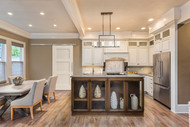A Guide to Interior Design Styles: Transitional Style
Dec 3rd 2018
Transitional style is a dynamic style that combines traditional and contemporary to achieve a timeless modern mix of masculine and feminine, with clean and classic lines. Transitional is of the moment these days as many millennials are looking to combine styles, old with the new, to create their own interior design styles. Let’s examine how you can create a transitional style in your own home.
What Is Transitional Design?
Transitional design is a new take on an old classic, traditional design. Transitional design is equally masculine and feminine using the combination of curved pieces with straight-lined furnishings and lacquered finishes. Transitional is not an eclectic mess. It is a gently accessorized, simple room with added composition and a neutral color palette.
It is the Art of Mixing
There are many successful interpretations of this look, you just need to remember to mix modern/contemporary and traditional to achieve a great transitional look. For example:
●Your furniture should take center stage, your palate should be neutral and warm.
●Add texture with wood, glass, fabric, steel, and metal.
●Limit accessories. You are already challenging the eye with different design elements, no need to overwhelm with lots of added pieces.
●Use art. This is where one large painting or photograph is enough. No need for groups of art all over the room. Pick one impactful piece.
●Use a barn door. These come in a range of design styles from traditional to rustic to modern. Pick a style that complements your room’s current style and furnishings to get that wonderful mix of a transitional look. Contact us if you need help choosing the right barn door for you.
Room by Room
Another great way to figure out how to go transitional is to take it room by room. Let’s start with a living room with traditional features like moldings and trims. Balance that to bring transitional style in by adding clean-lined sofas and chairs in warm neutral colors. On the other hand, if your architecture is modern with concrete floors and industrial lighting, you can add a traditional sofa and chairs in a subdued palate.
In your dining room, balance modern lighting features, like steel pendants with exposed light bulbs with traditional furnishings. Or, if you have or prefer more modern furniture, use a modern dining table and chairs, upholstering the chairs with a traditional fabric. It’s the contrast and mix of the two styles that create the transitional look.
If your bedroom furniture has a traditional look, such as a tufted or curved headboard, try upholstering it in an unexpected color like steel gray to bring the modern in. Alternatively, if you have a modern headboard, think about picking up traditional (or even antique) night stands to contrast the modern and create a transitional look.
In the bathroom, use different textures to create a transitional look, wood, metal, glass, and ceramic. Install modern tiles if you have a traditional deep clawfoot tub. If you’re working with a modern bathroom, accessorize with traditional elements like a vintage vanity.
Finally, the kitchen, which is the heart of the home. If you have traditional kitchen cabinets and you don’t want to replace them, contemporary pendant light fixtures will bring in the modern. You can always replace countertops with steel or concrete to add a modern touch. If you are living in a modern home with a contemporary kitchen and want the transitional look, think about a vintage chandelier, possibly changing the pulls on the cabinets (or redoing the cabinets entirely), or adding some classic wood like a butcher block table. It’s all about the contrast and the mixing of styles.
As you can see there are many ways to achieve the transitional design style, our favorite includes the addition of your choice of a barn door. They come in so many great styles to complement your home’s design. Have a look and let us know how we can help you pick your favorite.
